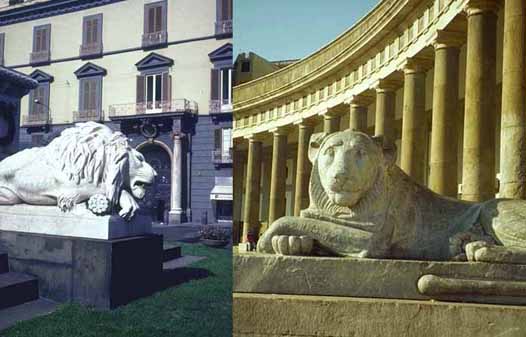| Two Lions

There
are loads of lions in Naples. The statue on the left is just one of
four at the base of the Monument to the Martyrs on Piazza dei Martiri.
The square is one block in from the Piazza Vittoria end of the Villa
Comunale. The square was originally dedicated to Santa Maria a Cappella,
but took on patriotic significance when Italy was united in 1860. A memorial
column was moved from a different site in Naples and the lions were added.
Each of the four animals represents a different patriotic struggle: the
Neapolitan revolution of 1799; the uprisings
in 1820 and 1848, and the war of unification
in 1860.
Still on
the left, the animal in the photo is across from the façade of
Palazzo Partanna (seen in the background). It is from 1746, but was redone
by King Ferdinand after the Bourbons returned to Naples in 1815. He wanted
to present it to his so-called "morganatic" * wife --the commoner he had
married in 1814-- Luisa Migliaccio. She was the widow of the prince of
Partanna, hence the name of the building. Since the 1930s, it has served
housed primarily municipal office space. Interestingly, it is the second
home she got from Ferdinand. The first one was a magnificent villa high
up on the Vomero section of Naples, overlooking the bay. Those grounds
are today called the Villa Floridiana and
the building itself houses a ceramics museum.
The statue
on the right is lounging in front of the Church of San Francesco di Paola,
the Pantheon-looking structure on the west side of Piazza Plebiscito across from the Royal
Palace.
*morganatic:
an unusual term with a fascinating etymology, from matrimonium morganaticum,
literally "marriage with a morning gift," referring to a gift given to
the wife on the day of marriage, in lieu of any share in the husband's
property. The term designated a form of marriage in which a nobleman married
a woman of inferior social status with the provision that, although children
would be legitimate, neither they nor the wife might lay claim
to the husband's rank or property.
back to table of contents |
